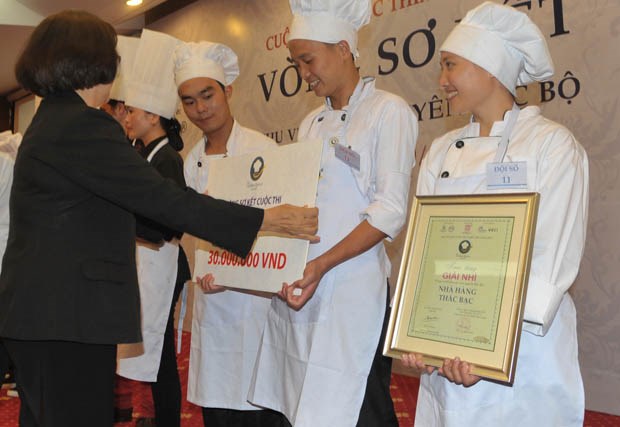Square sticky rice and rolls with sturgeon fish in the middle has a new and strange taste
People from around the world are
recognising the European Sturgeon as a delicious and nutritious fish. Some
businesses imported the fish to Vietnam and had farmed them successfully in Tam
Dao (Vinh Phuc province). Not everyone knows that the best sticky rice has very
good aroma and taste and comes from Sapa.
Seeing the layers of glutinous rice dyed
with a golden yellow of ripe sticky rice reminded them of the rice terraces in
Sapa. This is a view that has inspired people for years, especially artistic
photographers.
The spice that supports the two main
ingredients of sturgeon fish and sticky rice is cardamom, which grows wildly in
the jungle of the Northwest Region. It has a good spicy taste and the correct
aroma. Cardamom has medicinal elements said to prevent upset stomachs.
In the jungle the weather is of course,
humid and misty and it is easy to catch a cold. Therefore it is a good idea to
eat something hot to balance the body (extracted from the book “A choir of
spices” by Kim Phung- Dinh Cong Bay- NXB Publisher).
Some foreigners have tried this in Sapa and
have all made good comments. Young boys from Thailand, passionate about
mountain climbing, often buy one to keep in their backpack as a dried food to
eat on their long journey to the roof of Indochina, Mount Fansipan.
Similar to spring rolls, Sapa salmon is
also highly appreciated by the professional and experienced judges. However
cooking delicious food doesn’t necessarily mean that you have reached the standard
to take you to the final.
If you do not enjoy the
dish no charge will be made.
Some of professional foreign chefs used to
comment that Vietnamese food is fresh and delicious and abundant, but the
presentation is usually quite messy.
So the idea behind this contest is for the
judges to place an important focus on the presentation skills and also seeing
that the teams present the dishes in smaller portions that are more attractive
to diners.

They won with reckless ideas
The “Little Lady- Shop Owner” team of Thac
Bac Sapa restaurant scored well on presentation. In general their party table
looked like rice terraces with objects arranged in low and high positions. A
sheaf of rice was placed on a bamboo tube laying on a brocade fabric that was placed
under the bowls and white plates of Ly’s Horeca by Minh Long I Co. Ltd.)
The ceramic bowls and plates are blue in
color to represent the energy of trees and mountains. The white color
represents the small streams that meander around the highlands of the
Northwest. The combination is a harmony of traditional and the modern.
Thanks to this the team won the second
prize and entered the finals of the Golden Spoon 2014, which will be very
intensive and challenging.
|
Teams that won top
positions in the Northern highland region to enter to the final round of 2014
Golden Spoon contest:
The
best prize:
Swiss-Bel Hotel (Lao
Cai province)
Three
second prizes go to:
- Bao Chau Boutique-Lao
Cai
- Victoria Sa Pa- Lao
Cai
- Thac Bac Restaurant-
Sapa Lao Cai
Each prize is worth VND
30 million
|
“The presentation of team number 11 still had
some defects such as not enough fish in the square sticky rice. Their rolls
suffered from the same problem. Also the chef assistants didn’t wear the
correct uniforms but wore trousers more like a teenage fashion” commented Mr Long Thanh Chiem.
In addition, professional judge Suong Thi Bui also said that salmon and sturgeon brought to the contest by the team was
quite small (less than 2 kg). Yet a single Norwegian salmon weighs in at more
than a dozen kg. The filleted salmon simply wasn’t big enough to ensure its
sweetness and firmness. The skin of the sturgeon was also not thick and
crispy.. Even worse the chef wasn’t
careful enough and it was felt that the fish had been on the fire a little bit
too long, having a detrimental effect on the taste.
Despite all the issues,
Judges Suong remains a teacher who is always passionate about promoting
delicious Vietnamese food. He enjoyed
the food that was complemented by the seasoning, was professionally presented
and had a strong taste of the jungle and mountains, as well as being rich in
Chinese medicinal values. Dishes like (“móc
mật” leaves, a typical spice used in grilled barbecues in the Northwest; “củ khởi” leaves (Latin name Lycium
chinense or anise) which were presented by all the teams. She also discovered
that most of young chefs from this highland region weren’t trained on
professional courses, but most of the time dishes were passed down from master
to a student during their apprenticeships.
Therefore their cooking knowledge will lack some of the systems and
basic foundation related to cooking skills. Hopefully, the Lao Cai Tourism
department will take care of this gap.
Followed by Tan Toi
Photos:Tan Toi - Phi Nguyen
The Gioi Tiep Thi magazine